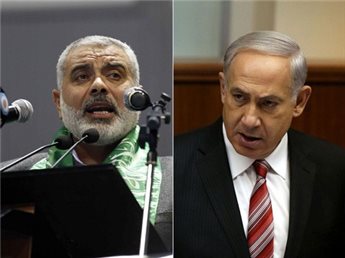When Ehud Olmert became prime minister after Ariel Sharon’s second stroke, he inherited a political plan from Sharon based on Israeli unilateralism in the West Bank, modeled on the unilateral withdrawal from Gaza. Sharon decided to withdraw from Gaza, reversing 30 years of settlement building, one year after stating that the future of Netzarim, a small Gaza settlement, was the same as the future of Tel Aviv. Sharon’s statement on Netzarim was an expression of his intent that Israel would never forsake the settlement project, of which he was its spiritual and implementational father. One year later he shockingly announced his decision for unilateral withdrawal from all of Gaza.
Palestinian Authority president Yasser Arafat was already dead when the Israeli government and army began to formalize the plans for the unilateral disengagement. Mahmoud Abbas had taken over the leadership on the Palestinian side. Abbas declared his complete opposition to violence. He stated that the militarization of the Second Intifada was both strategically and morally wrong. He promised to his people that through negotiations and diplomacy he would free their country and deliver an independent Palestinian state, based on the June 1967 borders with east Jerusalem as their capital, living in peace with the State of Israel.
Abbas believed that the first stage of liberation and statehood would begin with the Israeli withdrawal, and in its preparation, he established a coordination executive, headed by Mohammed Dahlan, with nine committees to work alongside of Israel, mainly with the National Security Council to developed a detailed and coordinated plan to take over Gaza. But then Sharon surprised everyone once again and declared that Abbas was not a partner and that he was in fact a “featherless chicken.” Israel would withdraw unilaterally, without negotiations and coordination with the Palestinians and without any Palestinian agreement.
Sharon had in fact planned the Israeli withdrawal with details aimed from the outset to foil any chance of Palestinian success. Israel left Gaza entirely to the international border and then locked the gates. Israel demolished all of the settlements and the Erez industrial zone and left Gaza without any chance of becoming Singapore as many had spoken about prior to the withdrawal. Sharon’s intention was clear: If the Palestinians failed in governing Gaza after the Israeli withdrawal, no one would pressure Israel into accepting a Palestinian state in the West Bank. Sharon intended to withdraw Israeli civilian presence in the West Bank more or less to the separation barrier, and to leave an IDF presence throughout the West Bank and along the Jordan River.
This would be another act of Israeli unilateralism without negotiating with the Palestinians and without allowing the Palestinians to have a real state, but ending, in Sharon’s mind, Israeli occupation over the Palestinian people. One year after the Israeli withdrawal from Gaza, Hamas took over after winning the elections, largely based on Hamas’s reasonable claim that they drove Israel out of Gaza and that Abbas failed to achieve anything for the Palestinian people.
IN 2008, three years after the disengagement and after Sharon was in a coma for years, Olmert was pressured by then-US president George Bush to renew negotiations with the Palestinians. The negotiations began on two separate tracks – one led publicly by foreign minister Tzipi Livni and the second track through private face-to-face meetings between Abbas and Olmert.
The Livni track made very little progress as the foreign minister demanded concessions from the Palestinians that, without getting parallel concessions from Israel, they were not prepared to make: recognizing Israel as a Jewish state and entirely giving up the right of return so that not one single refugee would return to Israel.
The Olmert-Abbas track progressed slowly but steadily while the two leaders developed a rapport and the beginning of trust. They met 42 times. By their final meeting they had reached agreements on principles for all of the core issues including Jerusalem, refugees, security, economics and water, and basically narrowed the differences to questions concerning the final borders.
They agreed on the principle of Israeli annexation of settlement blocs in the West Bank and Jewish neighborhoods in east Jerusalem and territorial swaps to ensure that a State of Palestine would be established on nearly 100% of the 22% of the Land of Israel between the River and the Sea, just as the Palestinians understood was incorporated the entire Olso deal.
The main point of difference between Abbas and Olmert was on Olmert’s demand to include the Ariel finger within the Israeli annexation going more than 20 kilometers inside the Palestinian state. Abbas refused this point and said that he wanted to come back with a Palestinian map which would be based on only 1.9% annexation by Israel instead of Olmert’s 6.5%.
Olmert refused to allow Abbas to take his map without signing his agreement on it. Abbas refused to sign. When he went back to his office in Ramallah, one of his advisers told me that he drew Olmert’s map by hand on a sheet of blank white paper. Olmert and Abbas agreed to meet again to continue the negotiations and decided that their aides, Saeb Erekat and Shalom Tourgeman, would set up the next meeting.
That meeting never happened. Olmert was indicted and resigned from heading the Kadima Party. Tzipi Livni, who expected to become prime minister, called Abbas and told him that Olmert had no legitimacy to continue negotiating and that he should wait until she was appointed prime minister. US secretary of state Condalezza Rice called Abbas and also told him that he needed to wait for Livni to take over and that he shouldn’t continue negotiating with Olmert. And the rest is history.

